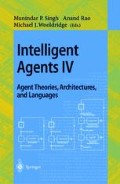Abstract
This paper gives a preliminary account of a system for developing autonomous agents operating in uncertain and rapidly changing environments. The decision-mechanism of an agent is specified in terms of behavior modules. Behavior modules specify what actions and submodules should be executed and under what conditions to fulfill some specific aims or purposes. Behavior modules can be executed simultaneously if they are compatible, allowing the agents to perform several tasks at the same time. The coordination between agents is mainly obtained through common tactics, strategies, and observations of actions of team members, rather than explicit communication. Agents act and coordinate with other agents depending on their roles.
This work has been supported by the Knut and Alice Wallenberg Foundation project Information Technology for Autonomous Aircraft.
Preview
Unable to display preview. Download preview PDF.
References
R. A. Brooks. How to build complete creatures rather than isolated cognitive simulators. In K. VanLehn, editor, Architectures for Intelligence. Lawrence Erlbaum Associates, 1991.
J. Bryson. Agent architecture as object oriented design. In this volume.
S. Ch'ng and L. Padgham. Role organisation and planning team strategies. In Proc. of the 20th Australian Computer Science Conference. Sydney, Australia, 1997.
S. Coradeschi, L. Karlsson, and A. Töme. Intelligent agents for aircraft combat simulation. In Proc. of the 6th Conf on Computer Generated Forces and Behavioral Representation. Orlando, FL, 1996.
R. J. Firby. The RAP language manual. Technical Report AAP-6, Univ. of Chicago, 1995.
M. P. Georgeff and F. F. Ingrand. Decision-making in an embedded reasoning system. In Proc. of IJCAI'89. Detroit, Michigan, 1989.
H. Kitano, M. Tambe, P. Stone, M. Veloso, S. Coradeschi, E. Osawa, H. Matsubara, I. Noda, and M. Asada. Robocup synthetic agent challenge 97. In Proc. of IJCAI'97. Nagoya, Japan, 1997.
J. E. Laird, R. M. Jones, and P. E. Nielsen. Coordinated behavior of computer generated forces in TacAir-Soar. In Proc. of the 4th Conference on Computer Generated Forces and Behavioral Representation. Orlando, FL, 1994.
D. W. Payton, D. Keirsey, D.M. Kimble, J. Krozel, and J. K. Rosenblatt. Do whatever works: a robust approach to fault-tolerant autonomous control. Journal of Applied Intelligence, 2:222–250, 1992.
P. S. Rosenbloom, J. E. Laird, A. Newell, and R. McCarl. A preliminary analysis of the Soar architecture as a basis for general intelligence. Artificial Intelligence, 47, 1991.
M. Tambe. Teamwork in real-world, dynamic environments. In Proc. of the 2nd International Conference on Multi-agent Systems (ICMAS-96). Kyoto, Japan, 1996.
Author information
Authors and Affiliations
Editor information
Rights and permissions
Copyright information
© 1998 Springer-Verlag Berlin Heidelberg
About this paper
Cite this paper
Coradeschi, S., Karlsson, L. (1998). A behavior-based approach to reactivity and coordination: A preliminary report. In: Singh, M.P., Rao, A., Wooldridge, M.J. (eds) Intelligent Agents IV Agent Theories, Architectures, and Languages. ATAL 1997. Lecture Notes in Computer Science, vol 1365. Springer, Berlin, Heidelberg. https://doi.org/10.1007/BFb0026753
Download citation
DOI: https://doi.org/10.1007/BFb0026753
Published:
Publisher Name: Springer, Berlin, Heidelberg
Print ISBN: 978-3-540-64162-9
Online ISBN: 978-3-540-69696-4
eBook Packages: Springer Book Archive

